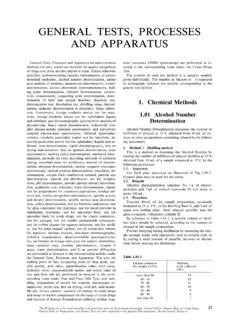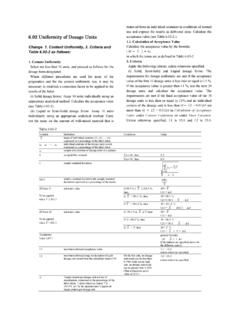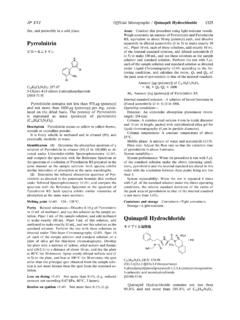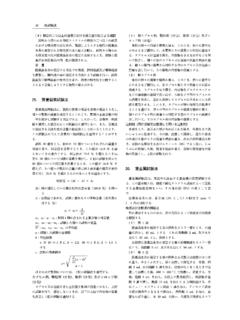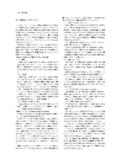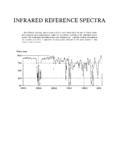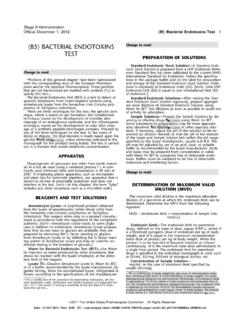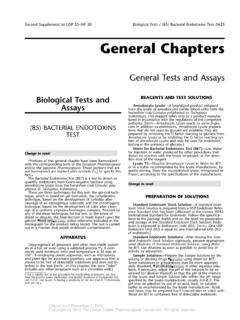Transcription of GENERAL TESTS, PROCESSES AND APPARATUS
1 25 Table content inthe sample (volz)Distillateto be collected(mL)more than 801380 701270 601160 501050 40940 308less than 30725 GENERAL TESTS, PROCESSESAND APPARATUSG eneral Tests, PROCESSES andApparatus includes commonmethods for tests, useful test methods for quality recognitionof drugs and other articles related to them. Unless otherwisespecified, acid-neutralizing capacity determination of gastro-intestinal medicines, alcoholnumber determination, aminoacid analysis of proteins, ammonium determination, arsenicdetermination, atomic absorption spectrophotometry, boil-ing point determination, chloride determination, conduc-tivity measurement, congealing point determination, deter-mination of bulk and tapped densities, digestion test, disinte-gration test, dissolution test, distilling range determination,endpoint determination in titrimetry, flame coloration,fluorometry, foreign insoluble matter test for injections, for-eign insoluble matter test for ophthalmic solutions, gas chro-matography, heavy metal determination, infrared spectro-photometry.
2 Insoluble particulate matter test for injections,insoluble particulate matter test for ophthalmic solutions,iron determination, liquid chromatography, loss on dryingdetermination, loss on ignitiondetermination, melting pointdetermination, methanol determination, microbial assay forantibiotics, mineral oil determination, nitrogen determina-tion, nuclear magnetic resonance spectroscopy, opticalrotation determination, osmolarity determination, oxygenflask combustion method, particle size determination, parti-cle size distribution test for preparations, pH determination,powder particle density determination, qualitative test,refractive index determination,residual solvents test, residueon ignition determination, specific gravity and density deter-mination, specific surface area determination, sulfate deter-mination, test for bacterial endotoxins, test for glass con-tainers for injections, test for metal particles in ophthalmicointments, test for microbial limit, test for microbial limitfor crude drugs, test for plastic containers, test for pyrogen,test for readily carbonizable substances, test for rubberclosure for aqueous infusions, test for sterility, test for totalorganic carbon, test of extractable volume for injection,thermal analysis, thin-layer chromatography, ultraviolet-visible spectrophotometry, uniformity of dosage units (testfor content uniformity, mass variation test)
3 , viscosity deter-mination, vitamin A assay, water determination, and X-raypowder diffraction are performed as directed in the cor-responding articles under the GENERAL Tests, PROCESSES andApparatus. The tests for melting point of fats, congealingpoint of fatty acids, specific gravity, acid value, saponifica-tion value, ester value, hydroxyl value, unsaponifiable mat-ter and iodine value of fats and fatty oils are performed asdirected in the corresponding items under Fats and FattyOils Test, and sampling, preparation of sample for analysis,microscopic examination, purity test, loss on drying, totalash, acid-insoluble ash, extract content, and essential oilcontent of crude drugs are performed as directed in the cor-responding items under Crude Drugs number of each test method is a category numbergiven individually.
4 The number in blackets (<>) appearedin monograph indicates the number corresponding to thegeneral test Chemical Alcohol NumberDeterminationAlcohol Number Determination represents the number ofmilliliters of ethanol at 159C obtained from 10 mL of tin-cture or other preparations containing ethanol by the follow-ing Method 1 Distilling methodThis is a method to determine the Alcohol Number byreading the number of milliliters of ethanol distillate at 159 Cobtained from 10 mL of a sample measured at 159 Cbythefollowing ApparatusUse hard glass APPARATUS as illustrated in Fig. glass may be used for the ReagentAlkaline phenolphthalein solution: To 1 g of phenol-phthalein add 7 mL of sodium hydroxide TS and water tomake 100 ProcedureTransfer 10 mL of the sample preparation, accuratelymeasured at 15 29C, to the distilling flask A, add 5 mL ofwater and boiling chips.
5 Distil ethanol carefully into theglass-stoppered, volumetric cylinder reference to Table , a suitable volume of distil-late (mL) should be collected, according to the content ofethanol in the sample bumping during distillation by rendering the sam-ple strongly acidic with phosphoric acid or sulfuric acid, orby adding a small amount of paraffin, beeswax or siliconeresin before starting the Alcohol Number Determination/ GENERAL TestsWhen the samples contain the following substances, carryout pretreatment as follows before distillation.(i) Glycerin: Add sufficient water to the sample so thatthe residue in the distilling flask, after distillation, containsat least 50zof water.(ii) Iodine: Decolorize the sample with zinc powder.
6 (iii) Volatile substances: Preparations containing appre-ciable proportions of essential oil, chloroform, diethyl etheror camphor require treatment as follows. Mix 10 mL of thesample, accurately measured, with 10 mL of saturated so-dium chloride solution in a separator, add 10 mL of petro-leum benzin, and shake. Collect the separated aqueous petroleum benzin layer was extracted with two 5 mLportions of saturated sodium chloride solution. Combine theaqueous layers, and distill. According to the ethanol contentin the sample, collect a volume of distillate 2 to 3 mL morethan that shown in the above Table.(iv) Other substances: Render preparations containingfree ammonia slightly acidic with dilute sulfuric acid. Ifvolatile acids are present, render the preparation slightlyalkaline with sodium hydroxide TS, and if the preparationscontain soap along with volatile substances, decompose thesoap with an excess of dilute sulfuric acid before the ex-traction with petroleum benzin in the treatment described in(iii).
7 To the distillate add 4 to 6 g of potassium carbonate and 1to 2 drops of alkaline phenolphthalein solution, and shakevigorously. If the aqueous layer shows no white turbidity,agitate the distillate with additional potassium allowing to stand in water at 15 29C for 30 minutes,read the volume of the upper reddish ethanol layer in mL,and regard it as the Alcohol Number. If there is no clearboundary surface between these two layers, shake vigorouslyafter addition of a few drops of water, then observe in thesame Method 2 Gas chromatographyThis is a method to determine the alcohol number by de-termining ethanol (C2H5OH)content(volz) from a samplemeasured at 159C by the following ReagentEthanol for alcohol number: Ethanol ( ) with deter-mined ethanol (C2H5OH) content.
8 The relation betweenspecific gravityd1515of ethanol and content of ethanol(C2H5OH) is volz, volz, Preparation of sample solution and standard solutionSample solution: Measure accurately a volume of sampleat 15 29C equivalent to about 5 mL of ethanol (C2H5OH),and add water to make exactly 50 mL. Measure accurately25 mL of this solution, add exactly 10 mL of the internalstandard solution, and add water to make 100 solution: Measure accurately 5 mL of ethanolfor alcohol number at the same temperature as the sample,and add water to make exactly 50 mL. Measure accurately25 mL of this solution, add exactly 10 mL of the internalstandard solution, and add water to make 100 ProcedurePlace 25 mL each of the sample solution and the standardsolution in a 100-mL, narrow-mouthed, cylindrical glass bot-tle sealed tightly with a rubber closure and aluminum band,immerse the bottle up to the neck in water, allowed to standat room temperature for more than 1 hour in a room with lit-tle change in temperature, shake gently so as not to splashthe solution on the closure, and allow to stand for 30minutes.
9 Perform the test with 1 mL each of the gas in thebottle with a syringe according to the Gas Chromatography< >under the following conditions, and calculate theratios,QTandQS, of the peak height of ethanol to that ofthe internal number QTQS 5(mL)a volume (mL) of sample ethanol (C2H5OH)content(volz)ofethanol for alcohol standard solution A solution of acetonitrile (3 in50).Operating conditions Detector: A hydrogen flame-ionization : A glass tube about 3 mm in inside diameter andabout m in length, packed with 150- to 180-mm porousethylvinylbenzene-divinylbenzene copolymer (mean pore27 Fig. APPARATUS for ammonium limit testFig. distilling APPARATUS for ammoniumlimit test27JP XVIG eneral Ammonium Limit Testsize: , 500 600 m2/g) for gas temperature: A constant temperature between1059C and gas: rate: Adjust the flow rate so that the retention timeof ethanol is 5 to 10 of column.
10 Proceed with 1 mL of the gas ob-tained from the standard solution in the bottle under theabove operating conditions, and calculate the a column giving elution of ethanol and the internalstandard in this order with the resolution between thesepeaks being not less than Ammonium Limit TestAmmonium Limit Test is a limit test for ammonium con-tained in each monograph, the permissible limit for ammonium(as NH 4) is described in terms of percentage (z) ApparatusUse a distilling APPARATUS forammonium limit test as illus-trated in Fig. For the distillation under reduced pres-sure, use the APPARATUS shown in Fig. Either appa-ratus are composed of hard glass, and ground-glass jointsmay be used. All rubber parts used in the APPARATUS shouldbe boiled for 10 to 30 minutes in sodium hydroxide TS andfor 30 to 60 minutes in water, and finally washed thoroughlywith water before Preparation of test solution and control solutionUnless otherwise specified, test solutions and control solu-tion are prepared as directed in the an amount of the sample, directed in the mono-graph, in the distilling flask A.
